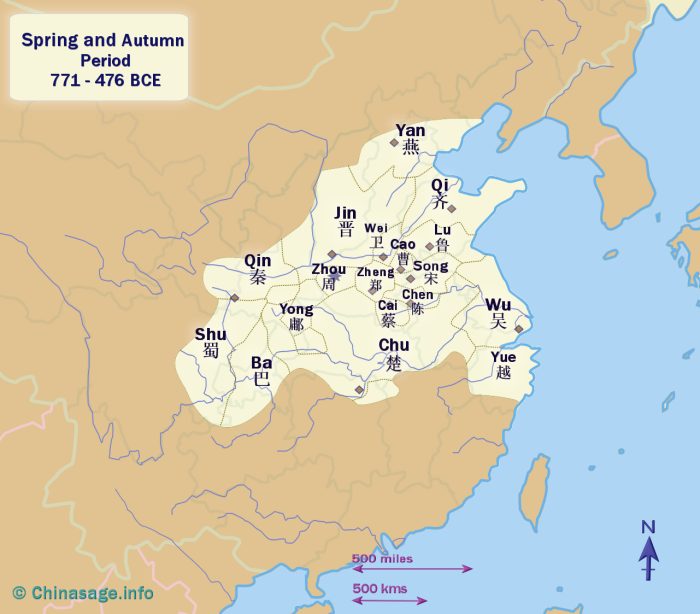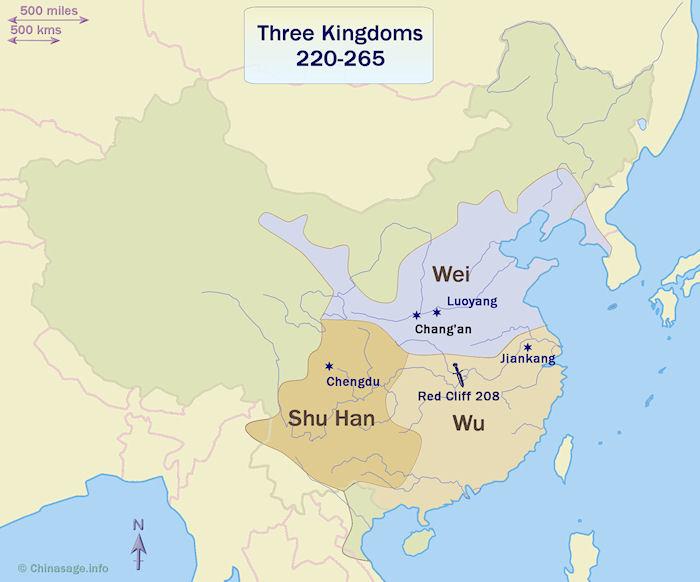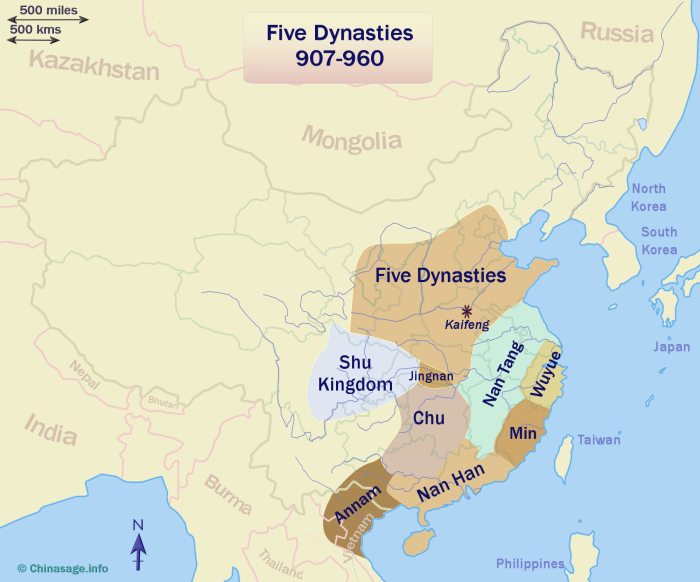Ancient states and kingdoms of China
China is usually thought of as one vast homogenous country and yet there are many regions which retain their own cultural identity. Before the Qin dynasty, over two thousand years ago, the core part of modern China was a patchwork of very small kingdoms. These ancient states would be just an academic study except that the names of the kingdoms crop up quite widely in Chinese literature. These old kingdoms are mentioned in poems and more significantly were around at the time of Confucius and so feature heavily in his writings. So it is useful to have a rough idea of where and when they existed.
Apart from the many states/kingdoms of the Zhou dynasty there are other periods of Chinese history when regions became independent. Confusingly some of these later divisions re-used the old Zhou names so it is easy to mix them up. We describe the kingdoms in two groups - those of the Zhou dynasty and then a group of later kingdoms and regional dynasties.
Kingdoms of the later Zhou dynasty
These kingdoms or states were clustered around the Yellow River. They were rules by a local fief with total control over a few towns and cities. Most books use the term ‘state’ but I think ‘kingdom’ more closely reflects their status. Areas outside the city walls were under much less control. Further details ➚
There was only token acknowledgment to the Zhou Emperors on matters of ritual in a situation rather like medieval Europe where there were many city states and one leader - the Pope - who had limited power except in areas of religion. The Zhou Emperor was the Lord of all under heaven while the rest were termed 君子 jūn zǐ ‘lords’ who were both educated and literate. Most lords claimed ancestry from the early Zhou emperors or the legendary emperors, it is possible that some were direct descendents of Shang dynasty aristocrats.

This is a map of the major kingdoms/states of the Spring and Autumn Period. Showing the approximate location of Yan, Qi, Jin, Wei, Cao, Lu, Qin, Zhou, Zheng, Song, Chen, Cai, Wu, Yong, Shu, Ba, Chu and Yue.
The boundaries of the kingdoms varied during the Zhou dynasty. There were 15 large states (only 11 considered 'true' states) and numerous smaller ones often based on a single city as the independent fiefdom of one individual. Most of the ‘Han Chinese’ were clustered around the Yellow River with peoples regarded as semi-barbarian to the north (Yan), west (Shu) and south (Chu).
From 685BCE the major kingdoms established the system of hegemony ➚ where one kingdom was considered the leading kingdom over its neighbors. These follow the rough date ranges Qi (685 - 643 BCE), Song (643 - 637 BCE), Jin (636 - 628 BCE), Qin (628 - 621 BCE) and finally Chu (613 - 591 BCE).
Here are a list of the major kingdoms - there were too many smaller ones to include. We refer to an excellent external site chinaknowledge.com for full details of these kingdoms. The kingdoms are in alphabetic order:
Cai蔡 Cài c.1100 - 447BCE
A small state that was south-west of Chen in present day south-eastern Henan. Founded by 蔡叔度 Cài shū dù. Capital was at 上蔡 Shàng cài, Henan then XinCai and Xiacai. Conquered by Chu in 447BCE. Further details ➚
Cao 曹 Cáo c.1100 - 476BCE
Middle sized state in south-western present day Shandong. Founded by 曹叔振铎 Cáo shū zhèn duó. Conquered by state of 宋 Sòng in 476BCE. Further details ➚
Chen 陈 陳 Chén c.1100 - 469BCE
Founded by 陈胡公 Chén hú gōng. An area now in south-eastern Henan and north-west Anhui. Capital at 宛丘 Wǎn qiū in present day 淮阳 Huái yáng county, Henan. Conquered by Chu in 469BCE. Further details ➚
Chu 楚 Chǔ c.1100 - 223BCE
Still used as an informal name for the area covered by Hubei and Hunan provinces. An important, large kingdom that at times spread into northern Anhui. Not one of the Yellow River central states and considered semi-barbarian. In around 650BCE it began to look north to the central kingdoms and an anti-Chu alliance was formed to hold back its expansion but internal division led to its demise. The legendary founder was 楚熊绎 Chǔ xióng yì. It is famous as the home kingdom of the earliest named poet and statesman Qu Yuan. Various capital cities including Danyang now Zigui, Hubei and Ruo now Shangruo, Hubei. Conquered by Qin in 223BCE. Further details ➚
Han 韩 (韓) Hán 403 - 230BCE
One of the divisions of Jin that split off to become independent. Southern part of Shanxi which then expanded into Henan. Founded by 韩武子 Hán wǔ zǐ Conquered by Qin. Further details ➚
Jin 晋 (晉) Jìn c.1100 - 376BCE
Centered on present-day Shanxi province the Jin state was one of the most powerful and largest of the states during the Zhou dynasty. It was founded by 姬虞 Jī yú a relative of the ruling Zhou Emperors but had been settled by people since the Xia dynasty. In 632BCE it defeated the Chu kingdom at the Battle of Chengpu ➚. Following civil war in the kingdom it split into three divisions Han, Wei and Zhao - known as the ‘Three Jin’ 三晋 Sān jìn, in 376BCE. Its capital was at Tang near modern Yicheng, Shanxi.Further details ➚
Lu 鲁 (魯) Lǔ c.1100 - 221BCE
Centered around its capital 奄 Yǎn - modern day 曲阜 Qū fù in present day south-western Shandong. Famous as birthplace of Confucius. Founded by 鲁周公 Lǔ zhōu gōng. Occupied by Chu in 255BCE and then absorbed into the Chu kingdom 221BCE. Further details ➚
Qi 齐 (齊) Qí c.1100 - 221BCE
Occupied the plains of present day northern Shandong. It became important as a producer of salt. Capital at 营丘 Yíng qiū in modern day 临淄 Linzi district of Zibo,Shandong. Founded by 齐太公 Qí tài gōng. It became involved in the intrigues that propelled the kingdoms into conflicts during the Warring states period. It took part in offensive expeditions in the region which further weakened the kingdom. Conquered by Qin 221BCE. Further details ➚
Qin 秦 Qín c.1100 - 221BCE
A semi-barbarian state in Western China centered on the Wei valley (present day Shaanxi with some parts of Gansu and Sichuan). Capital city at various sites including 平阳 Píng yáng, Shaanxi and 泾阳 Jīng yáng, Shaanxi. Legendary founder is 大业 Dà yè. It then grew to conquer all the other kingdoms and form the first unified empire in the Qin Dynasty. Further details ➚
Shu 蜀 Shǔ ? - 316BCE
Considered a barbarian state beyond the central states of China not sharing the same culture at this time. Covered eastern present day Sichuan. Legendary founder was 蚕丛 Cán cóng. Capital at 梦廓 Mèng kuò present day Chengdu. Conquered by Qin in 316BCE. Further details ➚
Song 宋 Sòng c.1100 - 286BCE
A small state south-east of Cao in modern eastern Henan. Conquered by Qi in 286BCE. Capital at 商丘 Shāng qiū, Henan. Founded by 禄父殷 Lù fù yīn.Further details ➚
Wei 卫 (衛) Wèi c.1100 - 221BCE
Small state of northern part of modern day Henan. Sometimes written ‘Wey’ to distinguish from 魏 Wèi. Capital at 沬 Mèi modern Qixian , Henan also moved to Cao , Diqiu and Yewang (all in Henan) . Founded by 卫康叔 Wèi kāng shū. Last of the regnal states to fall to the Qin. Further details ➚
Wei 魏 Wèi 403 - 230BCE
One of the divisions of Jin that split off to become independent. Covered Shanxi and part of Shaanxi and later western part of Shandong. Capital at 霍 Huò modern day Huoxian, Shanxi then moved to 安邑 Ān yì modern day Xiaxian, Shanxi. Conquered by Qin. Further details ➚
Wu 吴 Wú 吳 c.1100 - 473BCE
Semi-barbarian state around the lower Yangzi river (southern present day Jiangsu). Legendary founder 吴太伯 Wú tài bó. Conquered by Wei 473BCE. Further details ➚
Xue 薛 Xuē c.1100 - 418BCE
Small city state in eastern Shandong. Capital at modern day Tengzhou . Founded by 禺阳 Yù yáng. Conquered by Qi in 418BCE. Further details ➚
Yan 燕 Yān c.1100 - 222BCE
Semi-barbarian frontier state in north-eastern China from Hebei east into Liaoning. Capital was 蓟 Jì near present day Beijing. Legendary founder 燕召公 Yān shào gōng. Conquered by Qin 222BCE. Further details ➚
Zhao 赵 (趙) Zhào 403 - 230BCE
One of the divisions of Jin that split off to become independent. Covered the northern part of Shaanxi amd built a defensive wall precursor to Great Wall. Founded by 赵烈侯 Zhào liè hóu. Conquered by Qin.
Zheng 郑 (鄭) Zhèng 806 - 375BCE
Small state is southern present day Henan. Founded by 郑桓公 Zhèng huán gōng in 806BCE. Conquered by Han 375BCE. Further details ➚
Kingdoms at other times in Chinese history
Here are some of the large number of other regions and kingdoms that arose at various other times in Chinese history. Kingdoms are listed in alphabetic not date order:

Chu or 马楚 (馬楚)Mǎ chǔ 926 - 951CE
A short-lived kingdom that covered the modern state of Hunan with capital at Changsha the present-day provincial capital. It was founded by 马殷 Mǎ yīn. It became part of the Later Zhou kingdom to the north in 951CE. Not to be confused with the Zhou dynasty kingdom of Chu. Further details ➚
Jin dynasty 晋 (鄭) Jìn 265 - 420CE
Conventionally split into western and eastern periods. Not to be confused with the Zhou dynasty kingdom of Jin. Further details ➚
Later Jin dynasty 后晋 (後晉) Hòu jìn 907 - 660CE
Founded by 石敬瑭 Shí jìng táng. Not to be confused with the Zhou dynasty kingdom of Jin. Further details ➚
Min 闽 (閩) Mǐn 909 - 945CE
Min arose as one of the ten states in southern China during the Five Dynasties period. Occupied much of present day Fujian with capital at Fuzhou which was then called Changle. The brothers Wang Chao 王潮, Wang Shenzhi 王審知 occupied Fuzhou in 893CE the independent state protected by mountains managed to survive until 945 when it was conquered by the southern Tang under Li Randa which itself lingered on until 978 into the beginning of the Song dynasty. Further details ➚
Shu or 蜀汉 (蜀漢) Shǔ hàn 221 - 263CE
The westernmost of the Three Kingdoms. This covered the prosperous province of Sichuan. Founded by 刘备 Liú bèi but conquered by the Wei kingdom in 263. Not to be confused with the Zhou dynasty kingdom of Shu. Further details ➚

Wei or 曹魏 Cáo wèi 220 - 265CE
The northernmost of the Three Kingdoms. Founded by 曹操 Cáo cāo at the end of the Han dynasty. The ‘dynasty’ was short-lived and conquered by the Jin in 265. Not to be confused with the Zhou dynasty kingdoms of Wei. Further details ➚
Wu dynasty or 孙吴 (孫吳) Sūn wú 222 - 280CE
Founded by 孙权 Sūn quán as the southern of Three Kingdoms. Covered the whole of southern China south of the Yangzi down to northern Vietnam. The capital was at Nanjing then called 建业 jiàn yè. After Sun Quan's death a successional civil war weakened the state and it was conquered by the Jin Empire in 280. Not to be confused with other kingdoms named Wu. Further details ➚ and and here ➚
Wu or Wu-Yue 吴越 (吳越) 907 - 978CE
One of the ten states of southern China that sprang up after the collapse of the Tang dynasty. It was founded by 钱镠 Qián liú(852-932). Occupied an area roughly of present day Zhejiang and at times part of northern Fujian. It had its capital at Hangzhou. It was absorbed in the Song dynasty in 978CE. Not to be confused with other kingdoms named Wu.
Wu Empire or 杨吴 楊吳 Yáng wú 902 - 937CE
It was centered on modern day Jiangxi with parts of neighboring provinces. It was founded by 杨行密 Yáng xíng mì and had its capital at Yangzhou, Jiangsu then called Guangling. In 937 the area was conquered by the southern Tang. Not to be confused with other kingdoms named Wu. Further details ➚